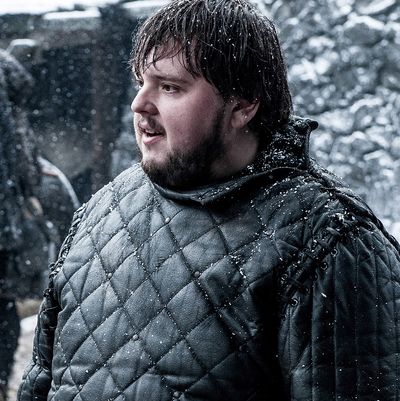
Spoilers ahead for Game of Thrones and A Song of Ice and Fire.
George R.R. Martin likes to refer to one problem he had while writing A Dance With Dragons as the Meereenese knot. (Show-watchers might remember this as the name of a sexual position referred to in Littlefinger’s brothel.) The knot was a tangle of characters — some scattered, some who needed to be introduced — and to untie the knot, Martin had to shuffle some story lines to make the Meereen plot work (and then get out of there). That was tough enough for the author, but for the TV showrunners, untangling this and other plots was even trickier, especially under a microscope. Fans second-guess every move that the showrunners make and cry out if a character is omitted, a plot point happens out of order, motivations are simplified, or, especially, if David Benioff and Dan Weiss dare make a call based on what they know about the endgame.
The thing is, Game of Thrones is not a one-book-per-season adaption. This season alone, Game of Thrones drew from book three, A Storm of Swords (Jon Snow’s route to becoming Lord Commander of the Night’s Watch); book four, A Feast for Crows (Cersei restoring the Faith Militant, Dorne’s plans for revenge, Arya’s assassin apprenticeship); book five, A Dance With Dragons (Stannis’s campaign, the Night’s Watch mutiny, Tyrion’s journey East, Dany’s attempts to keep the peace and learning to rule in Meereen, Cersei’s walk of shame), and even unpublished parts of book six, The Winds of Winter. But for the unpublished parts, Martin doesn’t give Benioff and Weiss every little detail — only bullet points, just enough to give them a road map. Overall, this means there’s less room to navigate and plan for the intricate plotting necessary for certain aspects of the story, things that take seasons to unfold (like the truth behind Jon Arryn’s murder). And it means less time for conspiracies and plots that fail, or go in circles. This season, we got the cleanest, clearest outline of the overall plot, from point A to point B, with the fewest possible detours. And from that, we get a glimpse of how the showrunners are approaching the material — the plot must go on, but certain characters don’t have to.
Is Ramsay still a sociopathic bastard, no matter whom he torments? Yes, point hammered home there. Does empathy eventually bring Theon back from Reek? Yes. The biggest wrinkle is what it does for Sansa, who has a very different story at this point in the books and is the subject of much debate. Now that she has the knowledge that Bran and Rickon are alive, she has a new mission. Perhaps this was originally someone else’s mission, but she’s the one taking the leap forward now, versus killing time in the Vale.
And if characters are cut (Aegon/Young Griff), plot points handed over to someone else (like giving Jeyne Poole’s marriage to Sansa, Jon Connington’s greyscale to Jorah), motivations changed (the plot in Dorne or the Night’s Watch mutiny), we are left to conclude that perhaps they didn’t matter quite as much to the endgame. If we didn’t get Aegon, it’s possible his claim to the throne wasn’t legitimate. Or perhaps he and his traveling party existed purely to convey Tyrion at least partway to his ultimate destination, and to introduce the threat of a greyscale contagion.
So far in the books, we haven’t seen much of the White Walkers, so for the showrunners to make this decision — to spend more time and money on that Hardhome scene than almost any other scene this season — they must have thought it was key, more so than the long, complicated, intricate Mance Rayder plot that eventually leads to the Night’s Watch mutiny. You can almost see them debating in the writers’ room: Which information is more important? Valyrian steel kills White Walkers, or Jon Snow has disgruntled co-workers? Which can they tell more quickly, and which could be visually stunning? Which one will drive home the point about the threat to the realm, the enormity of it?
And while the showrunners accelerated certain story lines to move the plot along (Stannis’s end, for one), there are others they can return to next season. Season six can play the same game as season five, taking material from multiple books and even presenting some plot points in a different order. Sam Tarly, who is now positioned to be a major player, can take us to the Citadel, where we can learn more about maesters, magic, and conspiracies. Various lords can still fight each other, openly or in secret, as they determine their allegiances. (The Northern lords who don’t wish to follow House Bolton, the Greyjoys who have their own ambitions, and the continuing war in the Riverlands). The displaced rural folk may also finally get some attention. But overall, we can probably expect to see the realm further weakened by civil war, mounting debt, and the threat of famine, as the White Walkers continue to the Wall.
All of this fits with the overall recurring refrain we got in most of the story lines this season: Houses will fall, and the games the high lords like to play are ultimately inconsequential. Anyone can die at any time. That’s the equality the smallfolk are used to, although they have hope that they might get equality in life as well as death, on some level. That’s the religious order’s appeal — that they even the playing field. It’s even the lesson Dany hopes to teach Westeros someday, when she “breaks the wheel.” When the White Walkers come recruiting for their army of the dead, will it matter if you’re highborn or lowborn, noble or slave, Stark or Lannister? We’ll have to ask the Night’s King come season six.

